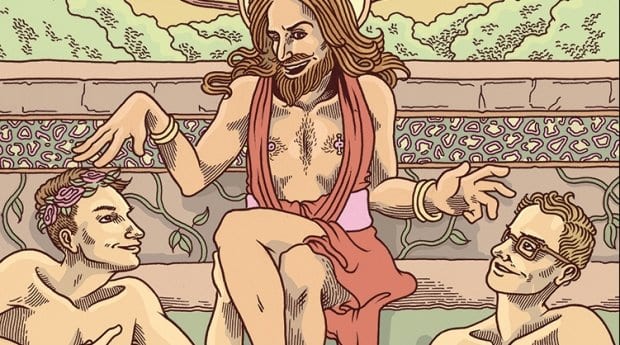When I hit puberty my developing attractions were strongly affected by my religious upbringing. Instead of confronting my desires when I started to have feelings for guys, I threw myself headfirst into religion: I went to youth retreats, taught Sunday school and even saw the pope at World Youth Day in Germany. Confusing, of course, to be raised to lead a “good” Christian life while masturbating to fantasies about hockey jocks from school. However, I recovered early from any spiritually related self-loathing and was born again into my critical, queer self.
It’s easy enough to find evidence to suggest Christ was gay, starting with the fact that he led a homosocial life, surrounded by men. His preference was for John the Apostle, one of his first disciples. Picture the scene at the last supper: “Now there was leaning on Jesus’ bosom one of his disciples, whom Jesus loved” — none other than John. “Simon Peter therefore beckoned to him, that he should ask who it should be of whom he spake. He then lying on Jesus’ breast saith unto him, Lord, who is it?” (John 13:23-25) This coded relationship is not lost on artists and theologians. Among others, 17th-century French painter Simon Vouet portrays John as a gorgeous youth with coquettishly parted lips. In Leonardo da Vinci’s famous Last Supper, John, seated to Christ’s right, appears more heartbroken androgyne than impassioned disciple. Jeremy Bentham, a 19th-century philosopher, points to Mark 14:51-52, wherein, following the betrayal of Jesus, “there followed him a certain young man, having a linen cloth cast about his naked body; and the young men laid hold on him: and he left the linen cloth, and fled from them naked.” He believed the young man to be a rent-boy, a “rival to the Apostle [John].”
The Gospel of Mark is attributed to another disciple, Mark the Evangelist. The fragments of this non-canonical apocrypha were uncovered by historian Morton Smith in a letter found in a Greek Orthodox monastery over-looking Bethlehem. The letter was written by Clement of Alexandria, a second-century theologian, replying to pleas for help in eradicating a Gnostic sect that incorporated pederasty into baptismal rights. Clement describes the passage in Mark’s gospel the sect used to justify their belief in having sexual relations with underaged boys. It tells of a woman who convinced Jesus to visit the tomb of her brother for a routine resurrection: “And straightway, going in where the youth was, he stretched forth his hand and raised him, seizing his hand. But the youth, looking upon him, loved him and began to beseech him that he might be with him. And after six days Jesus told him what to do and in the evening the youth comes to him, wearing a linen cloth over his naked body. And he remained with him that night, for Jesus taught him the mystery of the Kingdom of God.”
Unfazed by the steamy passage, Clement expressed his fervent belief that this was knowledge only for an elite initiated into the highest teachings of Christ. He was more scandalized by the sect’s other “unspeakable teachings,” which included worshipping images of Pythagoras, Aristotle and Plato. Gnosticism (the belief that secret knowledge could release the soul from the material world), Platonism and homosexuality are inseparable from Christ. Parallels between boy-loving Greek philosophers and the Messiah have been explored by academics, theologians and artists throughout history. L’École de Platon, by Belgian painter Jean Delville, depicts the school of Plato in an Edenic garden with the teacher surrounded by 12 young nude, reclining men. The painting is deliciously pornographic, and the bearded teacher is indistinguishable from depictions of Christ.
At best, the Bible should be a historical fiction of inconsistent moralizing tales; at worst, it’s a jumble of contradictory supernatural stories taken at face value to justify hatred, war and ignorance. It has often been reclaimed by faithful, but isolated, gay men looking for a place in an otherwise exclusionary faith. Luckily, we modern gays live in a more secular society, but for a homosexual man living in an uncomfortable historical period with no knowledge that others like him exist, there is something sacred about his faith in a gay Christ.
Editor’s Note: An earlier version of this story incorrectly stated that The Gospel of Mark was discovered by Ian Morton. It was actually uncovered by Morton Smith.


 Why you can trust Xtra
Why you can trust Xtra


